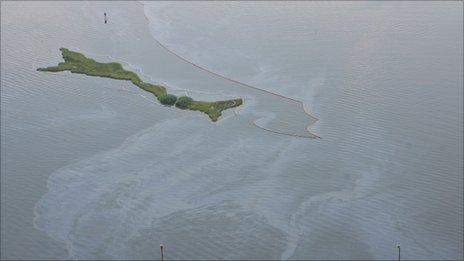BP oil spill: Undersea oil remains in Gulf of Mexico
- Published

A study of the effects of the Deepwater Horizon spill has confirmed the presence of a toxic chemical residue one kilometre below the sea surface.
The investigation, carried out in June, shows a plume of crude oil-based chemicals up to 200m high and 2km wide, extending 35km from the spill site.
The results are published in the journal Science.
There had already been speculation that large quantities of oil from the spill remained dissolved in the sea at depth.
This new research confirms that a plume, or cloud, does indeed exist below the surface. But it also shows that the amount is relatively small - possibly less than 0.1% of the total amount spilled.
Members of the research team from the Woods Hole Oceanographic Institute in Massachusetts, US, have been cautious about commenting on the significance of their study.
Dr Chris Reddy of the Woods Hole Oceanographic Institute, who was among those involved in the research, said he was unable to speculate, at this stage, what impact the plume would have on marine life in the area.
"I'd [need] a much better inventory of all the molecules that make up the oil before [I could] start to get an idea," he said.
Jane Lubchenco, head of the National Oceanographic and Atmospheric Administration (NOAA), and one of the most senior scientists in the US, commented: "We are all served best by proceeding in a careful, thoughtful, and quantifiable manner, where we can actually document everything and share it publicly."
Marine experts said the US researchers' study offered an important insight into the extent of the oil spill's impact on the region's marine ecology.

Dr Simon Boxall from the University of Southampton, National Oceanography Centre, UK, said: "This is actually an optimistic outlook and allays fears that huge plumes of oil lie in the deep ocean."
Dr Martin Preston, an expert on marine pollution at the University of Liverpool, said that although the plume contained many toxic chemicals, they were at very low concentrations and at a depth where relatively few marine animals are found.
Any concerns that oxygen would be depleted by the plume breaking up and creating so-called "dead zones" were unfounded, he added.
"Oil plumes are normally broken up by microscopic organisms in a process that uses up oxygen in the sea water," he said.
"If this happens rapidly, oxygen can reach dangerously low levels at the expense of marine animals. So the fact that the oil is breaking up slowly and moving away from the coastline is good news in the short-term."
But the plume's resilience means that there is also some bad news: the oil components are not degrading quickly and are likely to remain for several months or longer.
Dr Benjamin Van Mooy, another principal investigator of the research team, said: "If the oxygen data from the plume layer are telling us it isn't being rapidly consumed by microbes near the well the hydrocarbons could persist for some time.
"So it is possible that oil could be transported considerable distances from the well before being degraded."
Dr Boxall said it would be important to continue monitoring the region.
"Understanding how this plume is dispersing and breaking down will determine how quickly deepwater fishing can resume in the Gulf," he said.